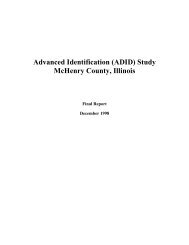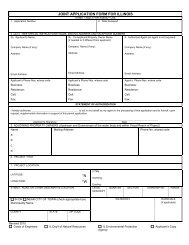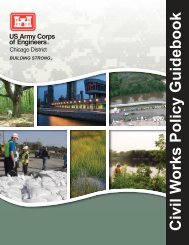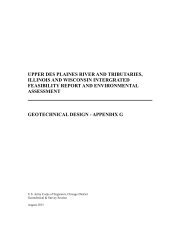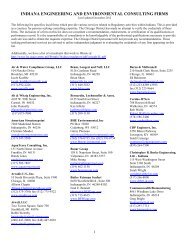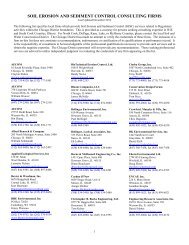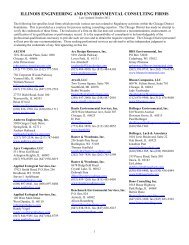APPENDIX A: HIGH-QUALITY AQUATIC RESOURCESThe following descriptions of high-quality aquatic resources apply to the Illinois portions of the <strong>Chicago</strong><strong>District</strong> only. This list is to be used as a guideline for identifying high quality resources in the six-countyregion, and is not all-inclusive.Advanced Identification (ADID) Sites: Aquatic sites that have been previously identified by the <strong>District</strong> andU.S. Environmental Protection Agency as areas generally unsuitable for disposal of dredged or fill material.ADID sites include various waters of the U.S., including wetlands, identified in Kane, Lake and McHenryCounties.Bog: A low nutrient peatland, usually in a glacial depression, that is acidic in the surface stratum. Bogs canhave non-flowering or very slow flowering water and their water levels fluctuate seasonally. Characteristic bogspecies include sphagnum (Sphagnum spp.), sundew (Drosera spp.), pitcher plant (Sarracenia purpurea),leatherleaf (Chamaedaphne calyculata), poison sumac (Rhus vernix), large cranberry (Vacciniummacrocarpon), dwarf birch (Betula pumila), and tamarack (Larix laricina).Ephemeral Wetlands: A seasonally inundated depression within a forest, savannah, or prairie usually locatedon a moraine, glacial outwash plain or in an area shallow to bedrock; also known locally as a “seasonal pond”or a “vernal pool.” These areas may not be permanently vegetated.Dune and Swale Complex: Areas usually oriented parallel to the Lake Michigan shoreline and typified bysandy, linear, upland ridges alternating with low-relief wetland created over time during changes in the LakeMichigan’s water levels. Black oak (Quercus velutina), paper birch (Betula papyrifera), jack pine (Pinusbanksiana), and prairie vegetation typically occur on the ridges and sedges, reeds, and marsh/aquatic vegetationare found in the swales. Dune and swale complexes are restricted to areas near Lake Michigan.Fen: An alkaline or calcareous, ground water-fed wetland. Fens are often a mosaic of grassy areas, sedgyareas, graminoid-shrub areas, and tall shrub areas. Typical plant species found within these mosaics include fenstar sedge (Carex sterilis), swamp thistle (Cirsium muticum), red-osier dogwood (Cornus stolonifera), brooklobelia (Lobelia kalmii), wild timothy (Muhlenbergia glomerata), grass of Parnassus (Parnassia glauca),shrubby cinquefoil (Potentilla fruticosa), and Ohio goldenrod (Solidago ohioensis). Fens can also be forested,with indicative tree species being eastern white cedar (Thuja occidentalis), yellow birch (Betula alleghaniensis),and black ash (Fraxinus nigra). Fens typically have a muck or peat substrate.Forested Wetland: A wetland dominated by at least one of the following native trees: red maple (Acerrubrum), kingnut hickory (Carya laciniosa), black ash (Fraxinus nigra), red ash (Fraxinus pennsylvanica),black gum (Nyssa sylvatica), white oak (Quercus alba), swamp white oak (Quercus bicolor), bur oak (Quercusmacrocarpa), pin oak (Quercus palustris), eastern white cedar (Thuja occidentalis), river birch (Betula nigra),yellow birch (Betula alleghaniensis), and slippery elm (Ulmus rubra).Sedge Meadow: An herbaceous wetland typically dominated by one or more of the following graminoidgenera, such as Calamagrostis, Cladium, Cyperus, Deschampsia, Eleocharis, Eriophorum, Juncus,Rhynchospora, Scleria, and Carex. Sedge meadows can be found along stream and lake margins or within riverfloodplains and upland depressions.Seep: A spring- or groundwater-fed herbaceous or thinly wooded wetland with saturated soil or inundationresulting from the diffuse flow of groundwater to the surface stratum. Often times seep wetlands are situated onor near the base of a slope. Characteristic seep wetland species include marsh marigold (Caltha palustris) andskunk cabbage (Symplocarpus foetidus).36
Streams rated A or B for Diversity or Integrity, or mapped as Biologically Significant: as described in theIntegrating Multiple Taxa in a Biological Stream Rating System published by the Illinois Department of NaturalResources.Wet Prairie: A wetland dominated by native graminoid species but with abundant forbs. Wet prairies oftenremain saturated throughout the growing season which is sometimes due to a high water table. Species found ina high quality wet prairie are dominated by at least one of the following species: big shining aster (Asterpuniceus firmus), bluejoint (Calamagrostis canadensis), tall coreopsis (Coreopsis tripteris), rattlesnake master(Eryngium yuccifolium), marsh blazing star (Liatris spicata), narrow-leaved loosestrife (Lysimachiaquadriflora), small sundrops (Oenothera perennis), prairie sundrops (Oenothera pilosella), cowbane (Oxpolisrigidior), marsh phlox (Phlox glaberrima var. interior), and prairie cord grass (Spartina pectinata).Wetlands Supporting Federal or Illinois Endangered or Threatened Species: For current State-listedspecies, reference Illinois Endangered Species Protection Board’s “Checklist of Endangered and ThreatenedAnimals and Plants of Illinois” (found at www.dnr.state.il.us/ESPB/) and/or contact the Illinois Department ofNatural Resources. For Federally-listed species, reference the U.S. Fish and Wildlife Service’s “Endangeredand Threatened Wildlife and Plants” list (latest edition, www.fws.gov/midwest/endangered/lists/illinoiscty.html)and/or contact the U.S. Fish and Wildlife Service.Wetlands with a Floristic Quality Index of 20 or greater or a Mean C-Value of 3.5 or greater: ReferencePlants of the <strong>Chicago</strong> Region (F. Swink and G. Wilhelm, 4th edition, Indianapolis: Indiana Academy ofScience, 1994).Further information on the areas described above can be found in the U.S. Environmental Protection Agency’sAdvanced Identification studies for Kane, Lake and McHenry Counties(www.lrc.usace.army.mil/Missions/Regulatory/Illinois/ADIDMaps.aspx), the <strong>Chicago</strong> Wilderness’ BiodiversityRecovery Plan (www.chicagowilderness.org/pdf/biodiversity_recovery_plan.pdf), Swink and Wilhelm’s Plantsof the <strong>Chicago</strong> Region, and the Integrating Multiple Taxa in a Biological Stream Rating System published byIDNR (www.dnr.state.il.us/ORC/BioStrmRatings/index.htm).37



